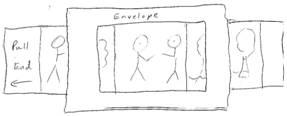Good Samaritan
THE GOOD SAMARITAN
 Objectives:
Objectives:
- Children should be able to identify this story as a parable of Jesus.
- Children should be able to tell the story in their own words.
- Children should have an understanding of what makes a good neighbor.
Possible Lesson Plan:
- Open with prayer. Use the Lord’s Prayer. Recite it a couple of times for memory practice.
- Read the story of the Good Samaritan in the Beginner’s Bible, pages 379-384, the Children’s Bible Reader, page 202, or the Read with Me Bible, pages 324-328. Supplement, if desired, with the Golden Children’s Bible, pages 412-413. Review the meaning of a parable, a story with a hidden meaning. Why did Jesus tell this story? What happened to the man in the story? Was the priest a good neighbor to this man? The Levite? Why or why not? Was the Samaritan man a good neighbor to the hurt man? Why?
- True/False Questions:
True False
The man was traveling to Jericho. The man was traveling to Bethlehem.
The man was hurt by robbers. The man had a safe and boring trip.
The priest passed the man without helping. The priest helped the man.
The Samaritan man helped the hurt man. The Samaritan hated the hurt man.
Add the Good Samaritan to your timeline:
- Discuss the concept of “neighbor”: Ask the children who are their neighbors. After a listing of friends and neighbors, try to expand their focus. Is the homeless man in the street who smells bad and is dirty also a neighbor? Is the child who steals their lunch money also a neighbor? Is the boy who hits them on the playground also a neighbor? Did Jewish people usually like Samaritans? Did Samaritans usually like Jewish people? Remind the children that the Samaritans were the descendants of the people who were not taken into Babylon in captivity; they married people of the land and were hated by the Jews when they returned. Was it easy for this Samaritan man to care for the Jewish man? Is it always easy to love other people and to do good things for them? Is there someone you find particularly difficult to love? Can you do something nice for them as a good neighbor?
 Make an Envelope Viewer Movie Strip. Cut a TV screen hole in the front of a business-size envelope. Lick the envelope shut and cut off both ends. Give each student a strip of paper divided comic-strip style into about 6 frames. Have them illustrate the story of the Good Samaritan; what are the most important scenes? Insert the strip in the viewer and pull through to see the whole story. Can they tell the story with their “movie”?
Make an Envelope Viewer Movie Strip. Cut a TV screen hole in the front of a business-size envelope. Lick the envelope shut and cut off both ends. Give each student a strip of paper divided comic-strip style into about 6 frames. Have them illustrate the story of the Good Samaritan; what are the most important scenes? Insert the strip in the viewer and pull through to see the whole story. Can they tell the story with their “movie”?- Close with prayer. Have each child think of a particular person who is hard to love and pray for that person and plan something nice for that person.